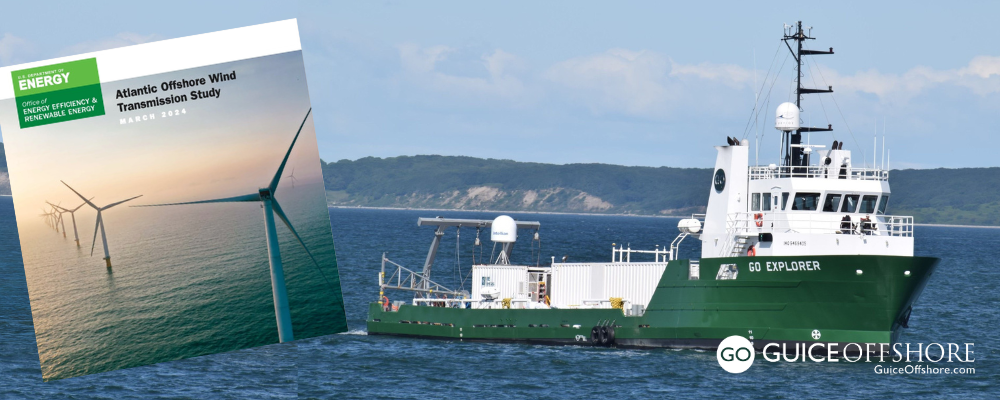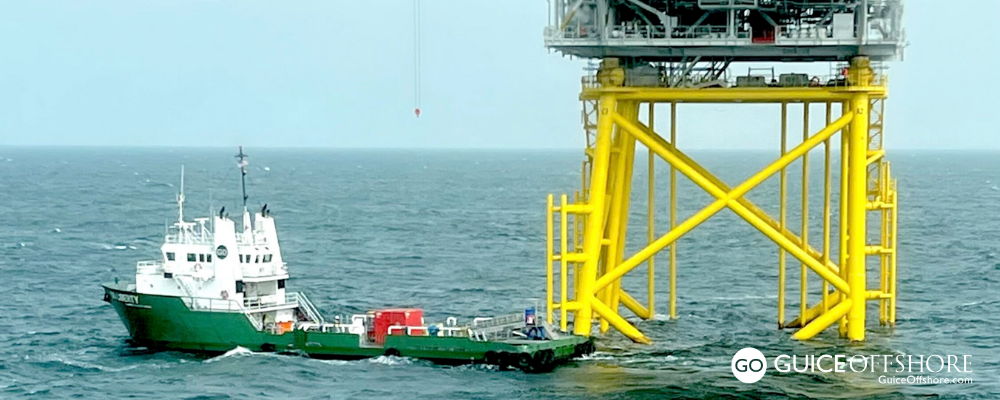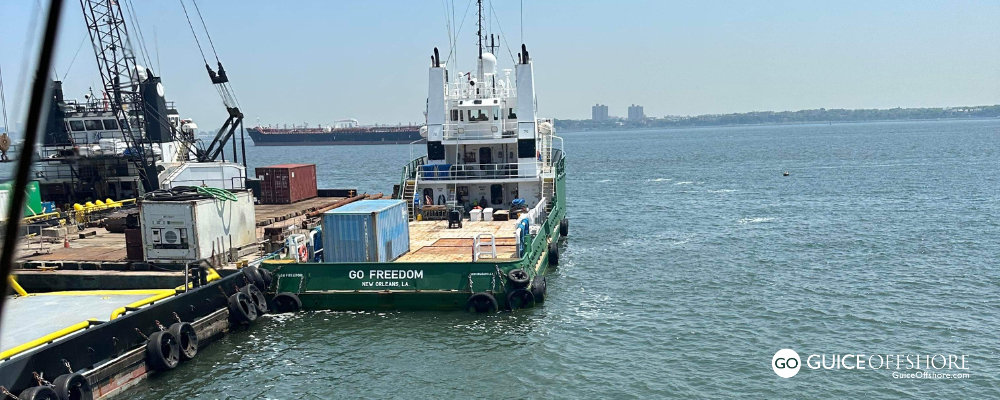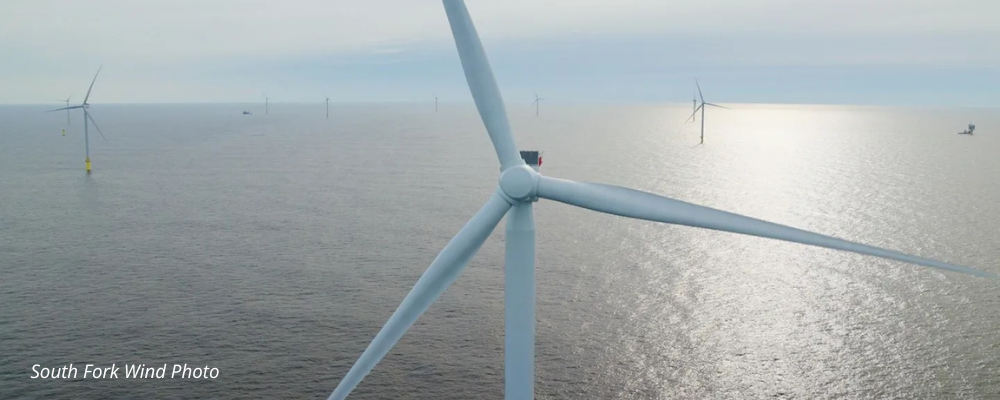Study Finds Interregional Offshore Transmission Network Would Support Long-Term Growth of Atlantic Offshore Wind, Action Plan Identifies Immediate Steps and Extended Efforts
During late March 2024, the U.S. Department of Energy (DOE) released findings from the Atlantic Offshore Wind Transmission Study, a two-year study evaluating transmission options to support offshore wind energy deployment along the Atlantic Coast of the United States. Offshore wind is projected to be a key part of a low-carbon future for East Coast states and this report is the most thorough analysis to date of options to bring Atlantic offshore wind energy to American communities.
While immediate projects will connect individually to the onshore grid, the study finds that after 2030, strategically linking some offshore wind energy projects via offshore transmission networks will help lower electricity production costs, enhance U.S. grid reliability, and reduce dependence on fossil fuels, while ensuring disruptions to oceanic ecosystems are minimal.
This study informed the Atlantic Offshore Wind Transmission Action Plan, also finalized in late March, which outlines immediate actions needed to connect the first generation of Atlantic offshore wind projects to the electric grid, as well as longer-term efforts to increase transmission over the next several decades.
“Offshore wind energy is already powering more than one hundred thousand homes along the east coast, with the potential to grow and further enhance grid reliability and reduce even more fossil fuels,” said U.S. Secretary of Energy Jennifer M. Granholm.
Atlantic Offshore Wind Transmission Study
The Atlantic Offshore Wind Transmission Study, conducted by researchers from DOE’s National Renewable Energy Laboratory and Pacific Northwest National Laboratory, analyzed various potential scenarios for offshore transmission off the Atlantic coast of United States. It estimates the costs and benefits of each pathway, accounting for grid reliability, resilience, and potential cable routes that consider environmental and siting constraints. It fills gaps identified in prior analyses by providing a multi-regional planning perspective.
The report shows that offshore wind energy development presents a unique opportunity to add transmission capacity to the East Coast’s power system, with the highest benefit from offshore transmission connecting areas across grid regions. This would allow offshore wind transmission to provide energy to areas of high demand and reduce grid congestion, increase system reliability, lower curtailment, and flow power from lower-price regions to higher price regions, reducing costs for consumers. This could also reduce generation from fossil-fueled-powered units by 5.5–9.2 Terawatt-hours per year in 2050.
Overall, the study found that connecting offshore wind platforms together to create transmission networks outweighs the costs, often by a ratio of 2 to 1 or more, when compared with each project having its own isolated transmission connections.
The report also identifies potentially feasible transmission corridors taking into consideration ocean co-use constraints such as military zones and shipping channels, as well as marine protected areas and artificial reefs. Actual potential points of interconnection should be determined by transparent processes and the locations used for the study are not intended to be precise suggestions.
The study, which was based on deploying 85 GW of offshore wind off the Atlantic Coast by 2050, recommends building offshore transmission in phases to help reduce development risk. It suggests early implementation of high-voltage direct current (HVDC) technology standards to support new transmission and facilitate future network expansion.
Atlantic Offshore Wind Transmission Action Plan
The comprehensive final Atlantic Offshore Wind Transmission Action Plan confirms the initial findings released in late 2023, and details how wind resources could efficiently be captured off the Atlantic Coast of the United States and delivered to communities as clean, reliable power.
Partially funded through the Inflation Reduction Act, the Action Plan underscores DOE’s commitment to leveraging cutting-edge research and data to chart a sustainable, efficient path forward for offshore wind transmission. The Action Plan was also informed through a series of convening workshops with subject matter experts and decision makers, including tribal nations, state governments, and regional transmission operators held from April 2022 to March 2023.
Over the mid- to long-term, increased intra-regional coordination, shared transmission lines, and an offshore network of high-voltage direct current (HVDC) interlinks can more efficiently bring critical, renewable offshore wind energy onshore.
The Atlantic Offshore Wind Transmission Study and report were funded by DOE’s Wind Energy Technologies Office. The Atlantic Offshore Wind Transmission Action Plan was led by DOE’s Grid Deployment Office, in partnership with the Wind Energy Technologies Office and the Department of Interior’s Bureau of Ocean Management.
You can sign up for the “Catch the Wind” newsletter and the Grid Deployment Office’s Offshore Wind listserv to receive periodic wind energy updates from the DOE.
U.S. Coast Guard, BSEE and BOEM Sign Agreement to Advance Safe and Environmentally Sustainable Energy Development
To strengthen interagency cooperation in the advancement of safe and environmentally sustainable non-mineral (renewable) energy development, including offshore wind, on the Outer Continental Shelf (OCS), the U.S. Coast Guard (USCG) signed a Memorandum of Understanding (MOU) on April 1, 2024 with two Department of the Interior bureaus: the Bureau of Safety and Environmental Enforcement (BSEE) and the Bureau of Ocean Energy Management (BOEM). U.S. Coast Guard Deputy Commandant for Operations Vice Admiral Peter Gautier, BSEE Director Kevin Sligh and BOEM Deputy Director Dr. Walter Cruickshank signed the MOU during a ceremony at the USCG Headquarters in Washington, D.C.
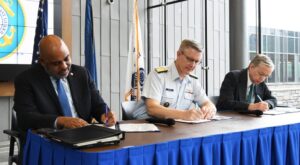
The new agreement strengthens federal collaboration in support of the Biden-Harris administration’s priority to deploy clean energy to combat the global climate crisis. USCG, BSEE and BOEM share responsibilities for the planning, siting, construction, operation, maintenance and decommissioning of federal offshore non-mineral energy facilities. The memorandum will serve as a guide for coordination of respective roles for offshore safety and environmental protection in federal waters, and outlines agency leadership for specific oversight functions.
“I’m signing this historic MOU today to memorialize the partnership between the Coast Guard, BSEE, and BOEM. Our cooperation is vital to be prepared for the rapid growth in offshore activity supporting sustainable energy development. Together we will ensure that this activity will be safe, secure, and environmentally sound,” said Admiral Gautier.
“BSEE is committed to high standards for worker safety and environmental compliance during all offshore energy activities,” said BSEE Director Sligh. “The agreement signed today strengthens interagency communication and coordination, reduces gaps and redundancies in federal oversight, and helps us to leverage resources and expertise, all in the service of a mutual mission to provide for the safe and environmentally conscientious development of offshore renewable energy resources.”
“Government partnerships are essential for ensuring offshore renewable energy development is done efficiently and responsibly,” said BOEM Director Elizabeth Klein. “The agreement signed today focuses on enhancing interagency communication and coordination and leveraging institutional knowledge. Our agencies’ collective efforts can provide additional impetus to the advancement of offshore wind energy development for the benefit of all Americans.”
The MOU calls for USCG, BSEE and BOEM to:
- Coordinate on regulatory and policy development to promote consistency of regulations and policies where shared responsibilities exist.
- Strengthen communication and cooperation through information sharing, collaboration, synchronizing of information, and adoption of similar terminology, codes and standards, for clarity and consistency.
- Exchange services and personnel to support mutual work objectives when possible, allowing the agencies to leverage resources and expertise. The MOU does not obligate funds or staffing.
- Develop and implement additional Memoranda of Agreement under the MOU to provide specific guidance on each agency’s role and shared responsibilities for regulating various OCS activities and facilities.
The MOU replaces a previous agreement signed in 2011 by the USCG and the Bureau of Ocean Energy Management, Regulation and Enforcement, the predecessor agency to BOEM and BSEE.
The mission of the USCG on the Outer Continental Shelf is to ensure maritime safety, security, and environmental protection.
The mission of BSEE is to promote safety, protect the environment, and conserve resources offshore through vigorous regulatory oversight and enforcement of ocean energy, marine mineral, and carbon sequestration activities on the OCS.
The mission of BOEM is to manage development of U.S. Outer Continental Shelf energy, mineral, and geological resources in an environmentally and economically responsible way.
